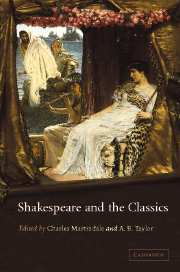Book contents
- Frontmatter
- Contents
- Notes on contributors
- List of abbreviations
- Introduction
- PART I AN INITIAL PERSPECTIVE
- PART II ‘SMALL LATINE’
- PART III ‘LESSE GREEK’
- PART IV THE RECEPTION OF SHAKESPEARE'S CLASSICISM
- 15 ‘The English Homer’: Shakespeare, Longinus, and English ‘neo-classicism’
- 16 ‘There is no end but addition’: the later reception of Shakespeare's classicism
- Select bibliography (compiled by Joanna Paul)
- Index
16 - ‘There is no end but addition’: the later reception of Shakespeare's classicism
Published online by Cambridge University Press: 22 September 2009
- Frontmatter
- Contents
- Notes on contributors
- List of abbreviations
- Introduction
- PART I AN INITIAL PERSPECTIVE
- PART II ‘SMALL LATINE’
- PART III ‘LESSE GREEK’
- PART IV THE RECEPTION OF SHAKESPEARE'S CLASSICISM
- 15 ‘The English Homer’: Shakespeare, Longinus, and English ‘neo-classicism’
- 16 ‘There is no end but addition’: the later reception of Shakespeare's classicism
- Select bibliography (compiled by Joanna Paul)
- Index
Summary
Today's readers of The Two Noble Kinsmen will already have most of Shakespeare's more celebrated oeuvre under their belt, and thus may experience a sense of déjà vu when they turn to this late work, written in collaboration with Fletcher. We are introduced to the Athenian Duke Theseus, who has just won Hippolyta as his bride, and watch him try to arbitrate in the quarrels of two young noblemen who are both in love with the same girl. Of course these features are already present in Chaucer and Boccaccio; but the unnamed ‘second countryman’ cannot be traced back to any such obvious source. He and his companions, who are planning a May Day dance to entertain the court, have few classical credentials:
All the boys in Athens
Blow wind i'th breech on's. And here I'll be,
And there I'll be for our town and here again,
And there again. Ha, boys, heigh for the weavers!
(2.3.46–9)This over-enthusiastic weaver irresistibly recalls Bottom; it is as though, following A Midsummer Night's Dream, he and his comrades are now immutably part of the Athenian landscape, always rehearsing to please the Duke. Within the complex historical and geographical matrix of educated reading practice there is a corner of a classical Athenian wood which will be forever Elizabethan England. The mechanicals' memorable performance also haunts this play.
Information
- Type
- Chapter
- Information
- Shakespeare and the Classics , pp. 277 - 293Publisher: Cambridge University PressPrint publication year: 2004
Accessibility standard: Unknown
Why this information is here
This section outlines the accessibility features of this content - including support for screen readers, full keyboard navigation and high-contrast display options. This may not be relevant for you.Accessibility Information
- 1
- Cited by
